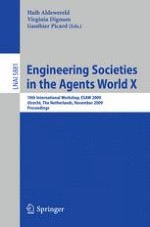The 10th international workshop “Engineering Societies in the Agents’ World” (ESAW 2009), was held in Utrecht, The Netherlands, during November 18–20, 2009. In the tradition of its predecessors, ESAW 2009 was committed to the idea of multi-agent systems (MAS) as highly interconnected societies of agents, paying particular attention to the social aspects, methodologies and software infrastructures that tackle the emergent complexities of MAS. The idea for the ESAW workshop series was born 10 years ago, in 1999, among the members of the working group on “Communication, Coordination and Collaboration” of AgentLink, the 1st European Network of Excellence on Agent-Based Computing, out of a critical discussion about the general mi- set of the agents community. Central to this discussion is the need for proper consideration of systematic aspects of MAS, acknowledging the importance of a multi-disciplinary approach, that takes into account the social, environmental and technological perspectives. These issues that are as actual today as they were in 1999, which is con?rmed by the steady interest in the ESAW workshop series that previous editions took place in: – Berlin, Germany, 2000 (LNAI 1972) – Prague, Czech Republic, 2001 (LNAI 2203) – Madrid, Spain, 2002 (LNAI 2577) – London, UK, 2003 (LNAI 3071) – Toulouse, France, 2004 (LNAI 3451) – Kusadasi, Turkey, 2005 (LNAI 3963) – Dublin, Ireland, 2006 (LNAI 4457) – Athens, Greece, 2007 (LNAI 4995) – Saint-Etienne, France, 2008 (LNAI 5485) This10thworkshopwasdevotedtothediscussionoftechnologies,methodologies and models for the engineering of complex applications based on MAS, and broughttogetherresearchersandcontributionsfrombothwithinandoutsidethe agents’?eld–fromsoftwareengineering,distributedsystems,socialsciences,and
